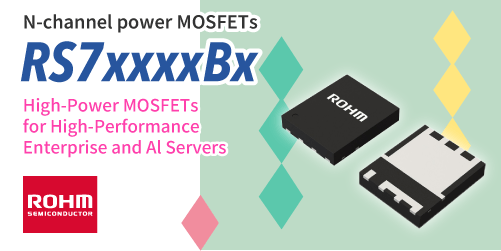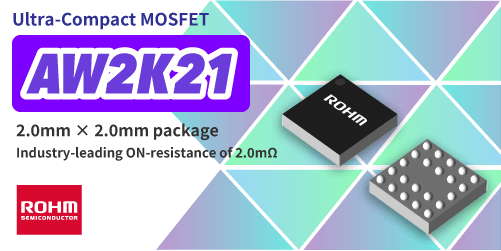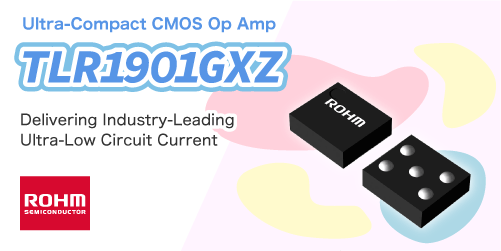

ROHM has developed external FET-type controller ICs utilizing PWM current control mode optimized for AC-DC power supply in various industrial applications. Mass production has begun for four variants designed to drive a wide range of power semiconductors: the BD28C55FJ-LB for low-voltage MOSFETs, BD28C54FJ-LB for medium- to high-voltage MOSFETs, BD28C57LFJ-LB for IGBTs, and BD28C57HFJ-LB for SiC MOSFETs.
Although the global semiconductor shortage is beginning to ease, the supply of semiconductor components for power supplies in industrial applications continues to lag behind demand. This is particularly true for PWM controller ICs, where the limited number of manufacturers has resulted in chronic shortages, leading to numerous requests for product development.
In response, ROHM has developed PWM controller ICs that address the ongoing supply issue by meeting the industrial market’s stringent package and performance requirements. Depending upon the input AC voltage range of the application, a wide variety of semiconductors are used for power supply circuit. Each of these semiconductors demand different undervoltage lock out levels to prevent thermal runaway in case of supply/gate voltage drop. To solve this issue, ROHM has developed 4 variants with different undervoltage lock out levels.
The new products feature an input voltage range of 6.9V to 28.0V, circuit current up to 2.0mA, maximum startup current of 75µA, and a maximum duty cycle of 50%, offered in the standard SOP-J8 package (equivalent to the JEDEC SOIC8). The products are pin to pin compatible to standard products commonly used in power supply circuits, thus reducing re-design and modification efforts. All variants are equipped with a self-recovery-type undervoltage lockout function (UVLO) with voltage hysteresis. This significantly improves application reliability by reducing the threshold voltage error to ±5%, compared to the typical ±10% of standard products.
At the same time, these ICs are designated for long-term supply, thus ensuring continuous operation of long-life industrial equipment. Going forward, the lineup will be further expanded to include products suitable to drive high-voltage MOSFETs and GaN devices. More variants to support a maximum duty cycle of 100% are also being planned.
Product Lineup
| Part No. | Data Sheet |
Input Voltage [V] |
Circuit Current Max. [mA] |
Start-up Current [μA] |
(Under Voltage Lock Out Function) VDD UVLO [V] |
Target Switching Devices |
ON Duty Max. [%] |
Operating Temperature [℃] |
Package [mm] |
||
|---|---|---|---|---|---|---|---|---|---|---|---|
| Typ. | Max. | Standby | Restart | ||||||||
| NEW |
Buy DataSheet |
6.9 to 28.0 |
2.0 | 60 | 75 | 9.0 | 14.5 | MOS(LV, HV) |
50 | -40 to +125 |
 [4.90×6.00×1.65] |
| NEW |
Buy DataSheet |
7.6 | 8.4 | MOS (LV) |
|||||||
| NEW |
Buy DataSheet |
15.5 | 18.8 | SiC, IGBT |
|||||||
| NEW |
Buy DataSheet |
14.5 | 18.8 | IGBT, SiC |
|||||||
| ☆BD28C59FJ-LB | – | 12.5 | 16.0 | MOS (HV) |
|||||||
| ☆BD28C51FJ-LB | – | 6.6 | 7.0 | GaN, MOS(LV) |
|||||||
☆:Under Development
Application Examples
Industrial equipment: AC-DC power supplies, motor drive inverters, and other AC-powered devices
Terminology
- PWM Control Type
- Short for Pulse Width Modulation, a method for controlling power using semiconductors. The output power is controlled by varying the ratio of ON and OFF times within a fixed cycle.
- Duty Cycle
- The proportion of ON and OFF times as percentage of the switching period is known as ON- and OFF-duty cycle, respectively. It is common to refer to the ON-time ratio as the duty cycle.
Duty Cycle (%) = Pulse Width (t) / Period (T). - Self-Recovery Undervoltage Lockout Function (UVLO) with Voltage Hysteresis
- This function safety stops IC operation before the circuit inside the IC becomes abnormal when the input voltage drops below a threshold. For self-recovery types, the IC can become unstable by repeatedly stopping and starting near the threshold voltage, so a protection circuit with hysteresis is used to create a voltage difference between the stop and restart points.








